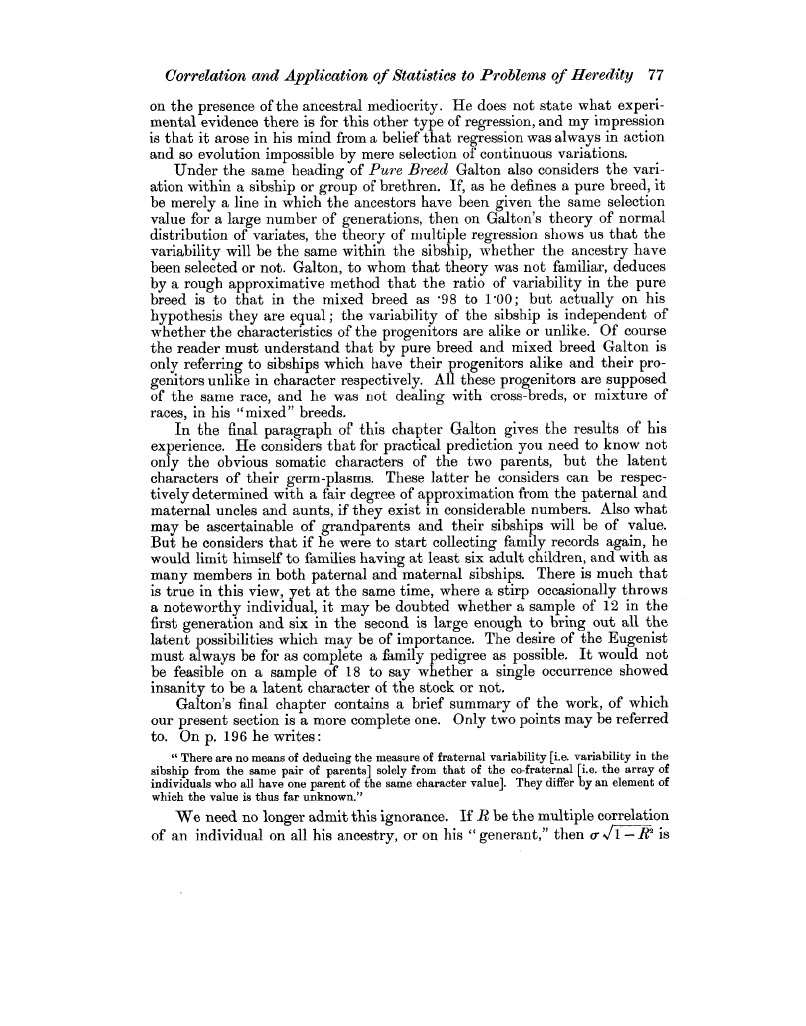| ||||||

OCR Rendition - approximate
Correlation and Application of Statistics to Problems of Heredity 77 on the presence of the ancestral mediocrity. He does not state what experimental evidence there is for this other type of regression, and my impression is that it arose in his mind from a belief that regression was always in action and so evolution impossible by mere selection of continuous variations. Under the same heading of Pure Breed Galton also considers the variation within a sibship or group of brethren. If, as he defines a pure breed, it be merely a line in which the ancestors have been given the same selection value for a large number of generations, then on Galton's theory of normal distribution of variates, the theory of multiple regression shows us that the variability will be the same within the sibship, whether the ancestry have been selected or not. Galton, to whom that theory was not familiar, deduces by a rough approximative method that the ratio of variability in the pure breed is to that in the mixed breed as •98 to 1.00; but actually on his hypothesis they are equal ; the variability of the sibship is independent of whether the characteristics of the progenitors are alike or unlike. Of course the reader must understand that by pure breed and mixed breed Galton is only referring to sibships which have their progenitors alike and their progenitors unlike in character respectively. All these progenitors are supposed of the same race, and he was not dealing with cross-breds, or mixture of races, in his "mixed" breeds. In the final paragraph of this chapter Galton gives the results of his experience. He considers that for practical prediction you need to know not only the obvious somatic characters of the two parents, but the latent characters of their germ-plasms. These latter he considers can be respectively determined with a fair degree of approximation from the paternal and maternal uncles and aunts, if they exist in considerable numbers. Also what may be ascertainable of grandparents and their sibships will be of value. But he considers that if he were to start collecting family records again, he would limit himself to families having at least six adult children, and with as many members in both paternal and maternal sibships. There is much that is true in this view, yet at the same time, where a stirp occasionally throws a noteworthy individual, it may be doubted whether a sample of 12 in the first generation and six in the second is large enough to bring out all the latent possibilities which may be of importance. The desire of the Eugenist must always be for as complete a family pedigree as possible. It would not be feasible on a sample of 18 to say whether a single occurrence showed insanity to be a latent character of the stock or not. Galton's final chapter contains a brief summary of the work, of which our present section is a more complete one. Only two points may be referred to. On p. 196 he writes " There are no means of deducing the measure of fraternal variability [i.e. variability in the sibship from the same pair of parents] solely from that of the co-fraternal [i.e. the array of individuals who all have one parent of the same character value]. They differ by an element of which the value is thus far unknown." We need no longer admit this ignorance. If R be the multiple correlation of an individual on all his ancestry, or on his " generant," then r %/1 - R2 is
|